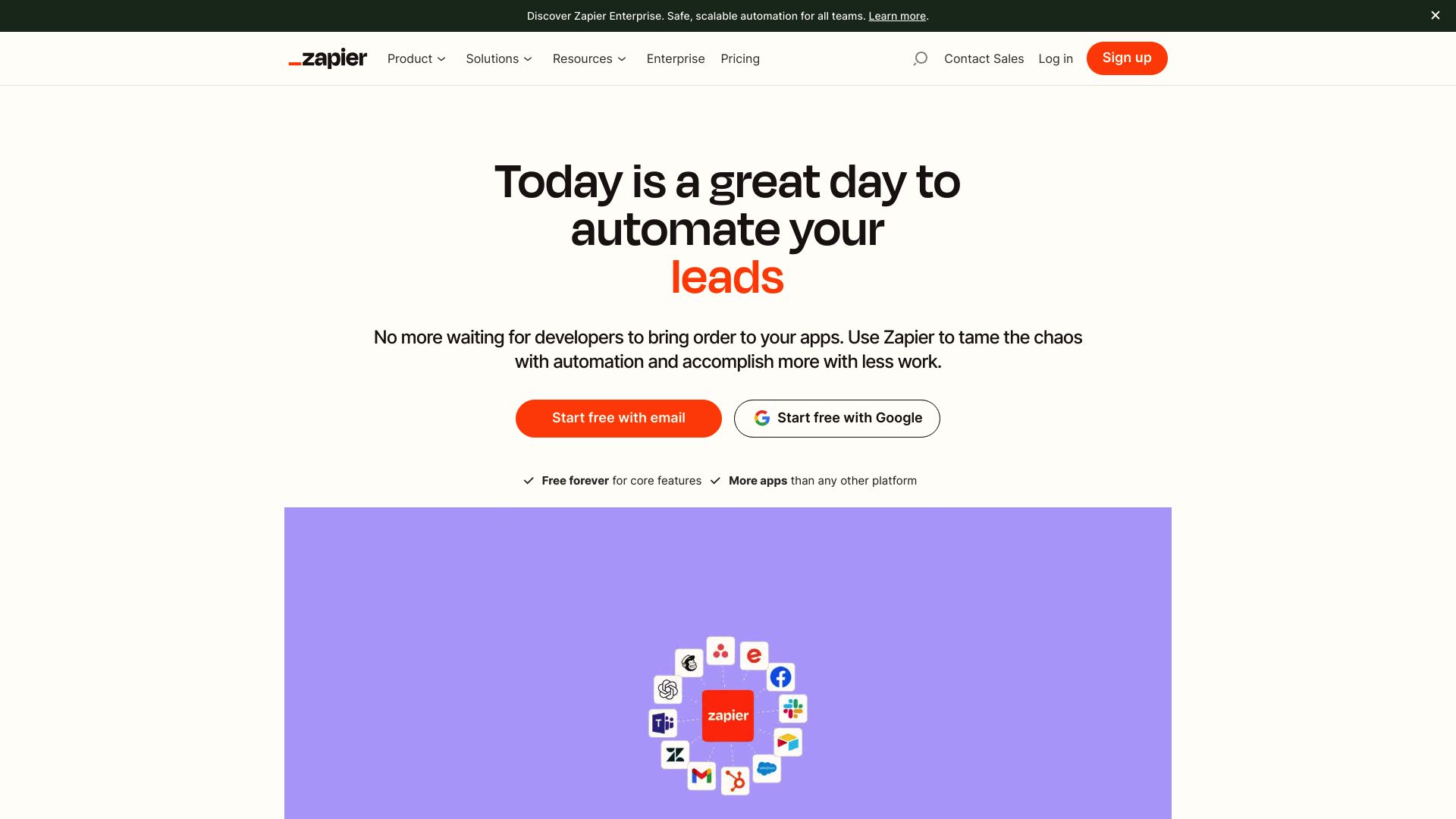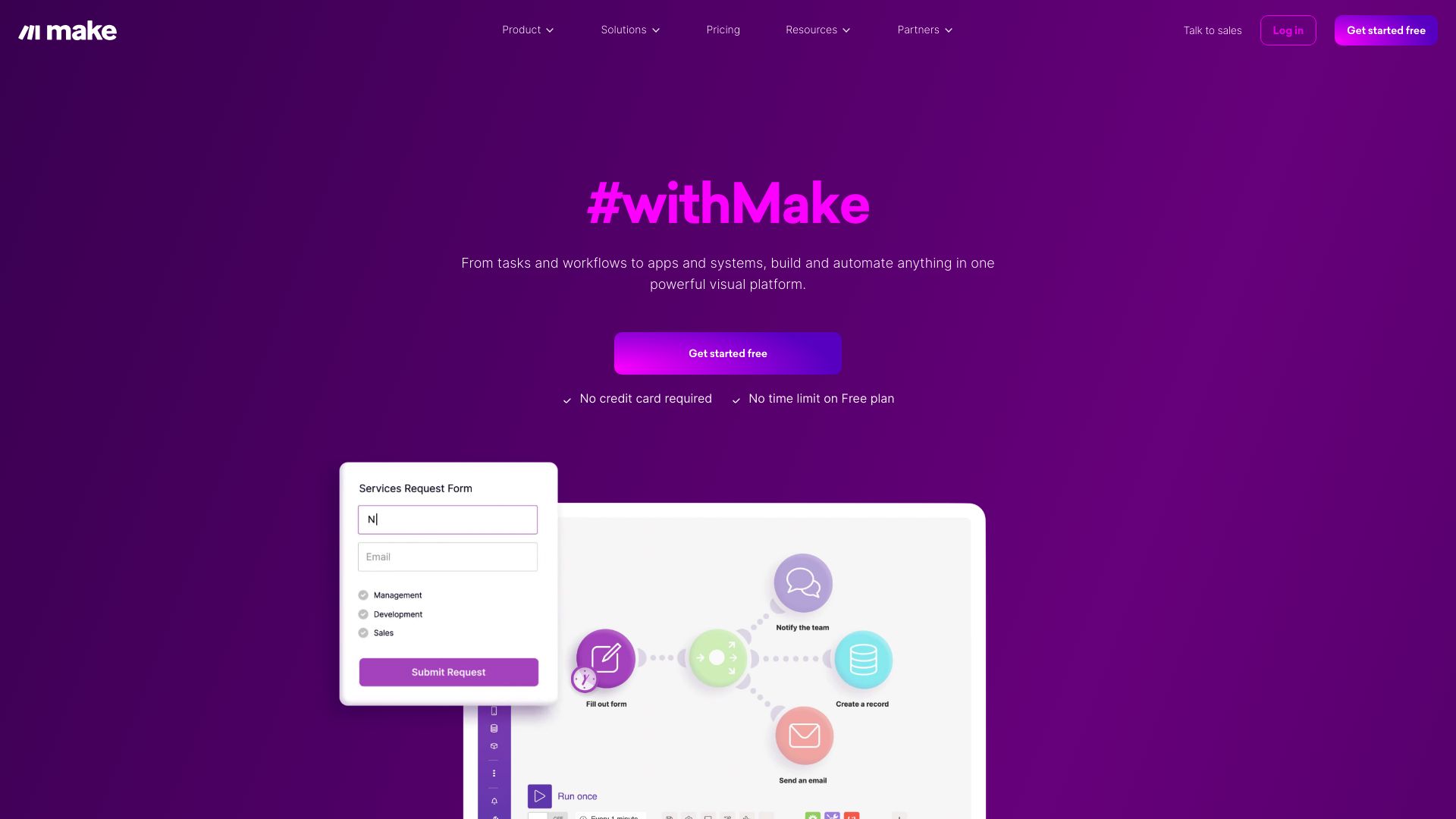Zapier vs. Make.com: AI-Powered Automation Showdown
AI-powered automation transforms the way businesses operate, offering unprecedented efficiency and innovation. This comparison examines Zapier vs. Make.com, and SmythOS, three platforms at the forefront of workflow automation and AI integration. Zapier connects over 6000 apps with its user-friendly interface, while Make.com offers a visual approach to creating complex automations. SmythOS, however, pushes the boundaries further by combining robust automation capabilities with advanced AI features. This review explores how each platform tackles workflow automation, their unique strengths, and why SmythOS stands out for businesses seeking to harness the full potential of AI-driven processes. Whether you’re a developer, business leader, or AI enthusiast, understanding these tools’ capabilities is crucial for staying competitive in today’s rapidly advancing technological landscape.
Zapier Overview
Zapier empowers users to connect and automate workflows across 6000+ web applications without writing code. This integration platform streamlines business processes by enabling the creation of custom workflows, called Zaps, that trigger actions based on specified events.


Zapier empowers users to connect and automate workflows across 6000+ web applications without writing code.
The platform caters to both technical and non-technical users through its dual-interface approach. The visual Platform UI facilitates no-code integration building, while the Platform CLI offers advanced customization options for developers. This flexibility allows businesses of all sizes to tailor automations to their specific needs.
Zapier’s strength lies in its extensive app ecosystem and user-friendly interface. Users can quickly set up integrations between popular services like G Suite, Slack, and Salesforce, saving time on repetitive tasks. The platform also supports webhook triggers and scheduled actions, expanding its utility for complex workflow automation.
While Zapier excels at connecting disparate systems, it lacks some advanced AI capabilities found in dedicated agent builders. The platform doesn’t offer features like autonomous agents, natural language processing, or multi-agent collaboration. However, for businesses primarily focused on streamlining workflows and integrating cloud services, Zapier provides a robust and accessible solution.
Make.com Overview
Make.com provides a visual automation platform for connecting apps and automating workflows without coding. The platform empowers users to create complex integrations called “scenarios” using an intuitive drag-and-drop interface.
Make.com provides a visual automation platform for connecting apps and automating workflows without coding.


Make.com offers over 1000 pre-built app integrations and allows connections to any API. Users can schedule scenarios to run automatically, visualize data flows in real-time, and collaborate across teams. The platform scales from free personal use to enterprise-grade solutions.
The platform scales from free personal use to enterprise-grade solutions.
Key features include the visual builder for rapid workflow creation, robust scheduling and triggers, detailed execution logs for debugging, and tools to transform and manipulate data. Make.com aims to help businesses automate manual processes by connecting their existing tools and services.
While Make.com excels at workflow automation, it lacks some advanced AI capabilities. The platform does not offer hosted AI agents, memory and context features, or autonomous agent functionality. For users seeking deeper AI integration, other specialized platforms may be more suitable.
Make.com’s strength lies in its accessibility for non-technical users and its extensive integration options. The visual interface and pre-built connectors allow quick deployment of automations. However, users requiring more complex AI-driven solutions may find the platform’s capabilities limited in that area.
Feature Comparison
Zapier and Make.com offer powerful workflow automation capabilities, but lack some advanced AI features found in SmythOS. Zapier connects over 6000 apps through its visual interface, while Make.com provides 1000+ pre-built integrations. Both platforms excel at no-code automation, allowing users to create complex workflows without programming.
However, neither Zapier nor Make.com offer hosted AI agents, autonomous agents, or multi-agent collaboration — key features of SmythOS. They also lack advanced AI capabilities like memory and context preservation, multimodal interactions, and problem-solving abilities. SmythOS provides these AI-focused features, enabling more sophisticated automations and intelligent workflows.
In terms of security, SmythOS offers more robust options including constrained alignment to ensure ethical AI behavior — a feature absent in Zapier and Make.com. While all three platforms provide data encryption and OAuth, SmythOS adds IP control for enhanced security. SmythOS also supports a wider range of AI models and data handling capabilities compared to the more limited options in Zapier and Make.com.
Feature Comparison Table
| Zapier | Make.com | SmythOS | |
|---|---|---|---|
| CORE FEATURES | |||
| AI Agents | ❌ | ❌ | ✅ |
| Hosted Agents (Dev, Production) | ❌ | ❌ | ✅ |
| Environments (Dev, Production) | ✅ | ❌ | ✅ |
| Memory & Context | ❌ | ❌ | ✅ |
| Autonomous Agents | ❌ | ❌ | ✅ |
| Explainability & Transparency | ❌ | ❌ | ✅ |
| Multimodal | ❌ | ❌ | ✅ |
| Problem-Solving Capabilities | ❌ | ❌ | ✅ |
| Multi-Agent Collaboration | ❌ | ❌ | ✅ |
| Human-AI Interaction | ❌ | ❌ | ✅ |
| Agent Work Scheduler | ❌ | ✅ | ✅ |
| SECURITY | |||
| Constrained Alignment | ❌ | ❌ | ✅ |
| Data Encryption | ✅ | ❌ | ✅ |
| IP Control | ❌ | ❌ | ✅ |
| COMPONENTS | |||
| Foundation AIs | ❌ | ❌ | ✅ |
| Huggingface AIs | ❌ | ❌ | ✅ |
| Zapier APIs | ✅ | ❌ | ✅ |
| Classifiers | ❌ | ❌ | ✅ |
| Logic | ❌ | ✅ | ✅ |
| Data Lakes | ❌ | ❌ | ✅ |
| DEPLOYMENT OPTIONS (EMBODIMENTS) | |||
| Deploy as API | ✅ | ❌ | ✅ |
| Staging Domains | ✅ | ❌ | ✅ |
| Production Domains | ✅ | ❌ | ✅ |
| Deploy as Site Chat | ❌ | ❌ | ✅ |
| Deploy as Scheduled Agent | ❌ | ✅ | ✅ |
| Deploy as GPT | ❌ | ✅ | ✅ |
| DATA LAKE SUPPORT | |||
| Hosted Vector Database | ❌ | ❌ | ✅ |
| Sitemap Crawler | ❌ | ❌ | ✅ |
| YouTube Transcript Crawler | ❌ | ❌ | ✅ |
| URL Crawler | ❌ | ❌ | ✅ |
| PDF Support | ❌ | ❌ | ✅ |
| Word File Support | ❌ | ❌ | ✅ |
| TXT File Support | ❌ | ❌ | ✅ |
Best Alternative to Zapier and Make.com
SmythOS stands out as the superior alternative to Zapier and Make.com for AI-powered automation. Our platform combines the workflow automation capabilities of traditional tools with advanced artificial intelligence features, delivering a more powerful and flexible solution.
We offer hosted AI agents that can operate autonomously, a key differentiator from Zapier and Make.com. These agents leverage memory and context to handle complex, multi-step tasks intelligently. Unlike basic integrations, our agents can make decisions, solve problems, and adapt their behavior based on changing conditions.
We offer hosted AI agents that can operate autonomously… Unlike basic integrations, our agents can make decisions, solve problems, and adapt their behavior based on changing conditions.
Our drag-and-drop visual builder makes creating sophisticated AI workflows as easy as using Zapier or Make.com. However, we provide far more advanced capabilities, including multi-agent collaboration, human-AI interaction, and support for multimodal inputs like text, images, and speech. This allows you to automate a much wider range of use cases beyond simple app integrations.
Security is paramount in AI systems, which is why we’ve implemented features like constrained alignment and IP control that are missing from Zapier and Make.com. We also support a broader range of AI models and data handling capabilities, including integration with foundation models, Hugging Face, and vector databases. This gives you more flexibility to build powerful, custom AI solutions tailored to your specific needs.
While Zapier and Make.com are limited in their deployment options, SmythOS allows you to expose your automations as APIs, chatbots, scheduled tasks, and even GPT plugins. Combined with our enterprise-grade scalability, SmythOS empowers you to embed intelligent automation throughout your entire technology stack. For organizations looking to harness the full potential of AI-driven automation, SmythOS is the clear choice over more limited workflow tools.
Conclusion
Zapier and Make.com offer powerful workflow automation capabilities, connecting thousands of apps and services without coding. Their visual interfaces and pre-built integrations allow quick deployment of automations for streamlining business processes. However, both platforms lack advanced AI features crucial for building sophisticated, intelligent workflows.
SmythOS emerges as the superior choice, combining robust automation with cutting-edge AI capabilities. Our platform offers hosted AI agents, autonomous operations, and multi-agent collaboration — features absent in Zapier and Make.com. SmythOS excels in memory management, multimodal interactions, and problem-solving, enabling more complex and intelligent automations.
Security stands out as another key advantage of SmythOS. We provide robust options like constrained alignment and IP control, ensuring ethical AI behavior and enhanced data protection. This comprehensive approach to security, coupled with our extensive AI model support and data handling capabilities, makes SmythOS the ideal choice for businesses seeking to harness the full potential of AI-driven automation.
Ready to revolutionize your workflow with AI-powered automation? Explore our diverse range of AI-powered agent templates to jumpstart your journey. Create a free SmythOS account today and experience the future of intelligent automation with no time limit and unlimited agents. Deploy your AI agents anywhere and transform your business processes with SmythOS.
Last updated:
Disclaimer: The information presented in this article is for general informational purposes only and is provided as is. While we strive to keep the content up-to-date and accurate, we make no representations or warranties of any kind, express or implied, about the completeness, accuracy, reliability, suitability, or availability of the information contained in this article.
Any reliance you place on such information is strictly at your own risk. We reserve the right to make additions, deletions, or modifications to the contents of this article at any time without prior notice.
In no event will we be liable for any loss or damage including without limitation, indirect or consequential loss or damage, or any loss or damage whatsoever arising from loss of data, profits, or any other loss not specified herein arising out of, or in connection with, the use of this article.
Despite our best efforts, this article may contain oversights, errors, or omissions. If you notice any inaccuracies or have concerns about the content, please report them through our content feedback form. Your input helps us maintain the quality and reliability of our information.
